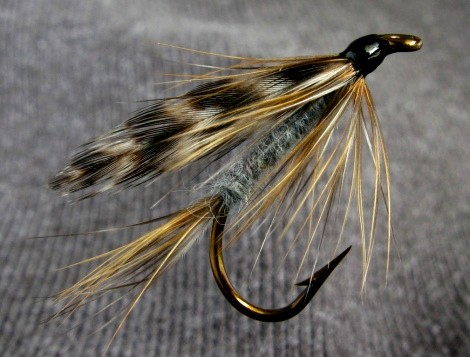
On The Fly
July 2011
"Fly tying is a school from which we never graduate"
TYING NEWS
The Southern Oregon Fly Tyers are on vacation for July and August. There will be no meeting
for those months. You are invited you to attend their meetings the second Tuesday of each month starting again
in September. The next meeting is September 13, 2011. The meetings start at 6:00 PM, at the Madrone Hill
Mobile Home Park community building near Gold Hill. Bring a friend, come early so you don't miss
anything, and stay late. Tyers need not be experienced, and those with all levels of skill are
welcome. Each meeting a member is encouraged to demonstrate a new or different skill, from simple
to difficult. For more information, call Dan Kellogg at 773-4724.
DIRECTIONS: Take Gold Hill Exit #40, off of I-5 and go west, toward Jacksonville, 1.3 miles, until you
reach the brick entrance way to the Madrone Hill Mobile Home Park on the right. You’ll pass a golf course
parking lot on your left shortly after leaving the freeway. After you turn right into the
mobile home park, proceed to the community building which is located about 100 yards ahead on the left. The
address is 8401 Old Stage Rd. Please park your vehicle on the bare dirt in the parking lot to avoid the
wooden septic covers in the grass
 PATTERN OF THE MONTH - Adams Wet
PATTERN OF THE MONTH - Adams Wet
Hook: Daiichi 1550, standard wet, size 16-14.
Thread: 8-0 black or dark gray
Tail: Brown and grizzly hen fibers, mixed.
Rib: Optional: fine wire or tying thread.
Body: Dark gray muskrat or rabbit fur.
Hackle: Brown and grizzly hen, one turn each.
Wing: Grizzly hen hackle tips, back to back.
Tying Instructions:
Step 1 Mash the barb and mount the hook in the vise.
Step 2: Start the thread one eye width behind the eye and lay down an even thread base to a position
just above the hook barb.
Step 3: Select a small bunch of brown and grizzly hen fibers. Measure tail 3/4 of shank length and tie
them on top of the hook just above the barb.
Step 4: Dub the tying thread with the dark gray fur and then advance it forward to the thread tie-in
position.
Step 5: Select one each brown and grizzly soft hen hackle feathers with fibers long enough to reach the
hook barb. Prepare and tie in at the front of the body with the shiny (convex) side facing forward. Tie
off and trim. Take one turn with each feather, tie off and trim. Take a couple wraps of tying thread
rearward over the hackle fibers to achieve the proper angle.
Step 6: Select a matching pair of grizzly hen hackle tips, even the tips with the dull (concave) side
facing back to back. Measure the length so tips reach halfway on the tail, tie them in on top of the
hackle wraps, and trim the butts.
Step 7: Form a neat head, whip finish and cement.
Most wet flies, which include the soft hackles, were not US inventions but imported
from the British Isles early in our fly fishing history before the advent of the dry fly. They were
effective then and have been somewhat forgotten since. Many of the most productive wet fly patterns were
ultimately converted to dry fly versions. Not so with this month's pattern.
The Adams Wet Fly was converted from one of the most popular dry flies in the world, the
Adams, a truly US fly. In 1922 Leonard Halladay developed the pattern and named it for the fisherman who
first used it, Charles Adams on Michigan's Broadman River. Since its inception there have been dozens of
dry variations using many different materials. We have also seen any number of Adams versions such as the
parachute, the emerger, the cripple, downwing, female, reversed, spent wing, thorax, well, you get the
idea. My point is that the Adams Wet Fly claims its heritage from the Granddaddy of them all. The most
widely used dry fly that does not directly imitate any specific natural trout food and yet consistently
produces results.
Wet fly patterns are fished sub-surface in the top or middle water column and are
designed to imitate adult may flies that have either drowned while floating on the surface of the stream
waiting for their wings to dry or have died while flying over the water after laying eggs. They differ from
dry flies in that they are made from soft hackle material instead of stiff hackle material and their wings
are swept to the rear instead of standing upright.
TYING TIPS
To blend the two colors of hackle fibers for the tail, simply roll them between your
thumb and forefinger before tying them in. I use ribbing on larger sizes only. On smaller sizes I prefer
a tighter, more segmented body without the bulky ribbing. This can be accomplished by forming a dubbing
loop after the dubbing has been applied to the thread. Twist the loop tight until the thread disappears
into the rope. The most difficult technique will be to get the wings to lay flat over the body with very
little angle. By stacking the hackle turns on top of the body and the wing on top of the hackle wraps, the
proper wing position will be much easier. The head will turn out larger in proportion, but that is common
with most wet flies.
So tie some up, give them a test flight and let me know how you do.
Tie One On,
Dan Kellogg
(you can contact me at FLYGUY@EZNORTHWEST.COM)
www.tyerstoolshop.com